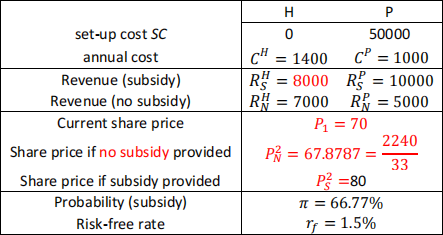关键词 > EC334
EC334 Assessed Problem set (2024)
发布时间:2024-06-26
Hello, dear friend, you can consult us at any time if you have any questions, add WeChat: daixieit
EC334 Assessed Problem set (2024)
Please complete both problems.
1. A firm produces electrically-assisted e-bikes. Currently, it produces a hybrid (“H”) model, which recharges the battery using the cyclist’s peddling energy. It has recently developed plans to switch to producing a plug-in (“P”) model whose battery must be charged from an EV charging socket. The firm is aware that the government is thinking about subsidising enhancements to the UK’s charging infrastructure, which would increase demand for the P model – this decision will be taken at the beginning of year 2, will take effect immediately and cannot be reversed. Currently, the firm estimates the associated costs and revenues as shown in the following Table. Annual costs for the H and P technologies are denoted CH or CP ; revenues from model i ∈ {H, P} in state k ∈ {s, N} for Subsidy (s) or No Subsidy
(N) are denoted Rk(i) .

If the firm switches to the plug-in (P) model now, the new facility will not come onstream till next year; this year, the firm will pay the set-up cost sC and the annual cost CH of producing the existing Hybrid (H) model and get revenues RN(H) . From next period onwards, the firm will pay annual cost Cp and get the relevant revenues (depending on the government’s decision regarding the subsidy policy).
The firm’s share price is correlated with the government decision as shown in the above table. After next period, the firm continues producing the chosen model (H or P) forever.
a. If the firm decides this year (before the government decision is known), what are the NPVs for the firm if i) it stays with H or ii) it switches to P, using the riskless rate for discounting? Which would the firm choose? [10 marks]
b. Using the share price, compute the WACC corresponding to sticking with the H model. Using this for discounting, what are the NPVs for each model and which would the firm prefer? [15 marks]
c. Using the WACC computed in part b, how much would the company be willing to pay for an option to delay the model choice until next year, once the government’s subsidy decision is known (assume the setup cost is paid when the decision is taken, one period before the new revenue stream starts)? [25 marks]
2. A manufacturer wishes to contract a manager for its retail outlet. The profits of the business depend on the state of the world (w, distributed uniformly on [0,1]) and the effort (e) supplied by the manager. Effort is costly; there is a cost included in the profit function
π (e, w) = Aew − e 2
In addition, the manager incurs a personal cost of βe and has an outside offer worth U ≥ 0. After the profits are earned, both the manager and the manufacturer learn the state and the manager’s effort (w and e). Assume that A = 30, β = 0.25 and U = 50.
a. If the manufacturer could observe the state (w) in advance, what would the optimal contract be (assume that the manufacturer must hire a manager)? [5 marks]
b. Now suppose that the manager does not observe the state w until after the contract is signed, but does learn the state before choosing e. Also assume that the manufacturer cannot observe anything in advance, and only observes profit afterwards, and therefore offers a profit-sharing contract that pays the manager a proportion σ of profit. Set up the firm’s optimisation problem and find the optimal profit-sharing level and expected payoffs to the firm and the manager. [15 marks]
c. Describe in words what how to set up the problem if the manager observed the state before signing the contract. What you would expect to happen to the payoffs of the two parties? [15 marks]
d. Now suppose that (as in part a) the manager does not observe the state w until after the contract is signed, but faces no personal cost (β = 0) and has no outside option. The firm can choose to audit the state and the manager’s effort after the manager reports the profit earned by the firm. This audit will cost ca = 100. If the manager reports profits of π, the firm will get a payoff of π if this exceeds a threshold or trigger level π * ; otherwise, if the firm conducts an audit, they will learn the true profit, the state and the manager’s effort. You may assume that if the manager is found to have supplied profit-maximising effort for the state, the manger gets a fixed payment of U = 0; otherwise, the manager is fined an amount F > 0 and the firm gets all the profit (but not the fine). Set up the problem and then find the audit trigger π * and the corresponding levels of effort supplied by the manager in each state. [15 marks]

